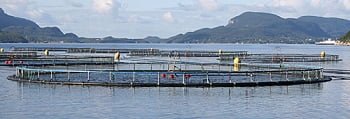
Keeping fish healthy is crucial for a sustainable and successful aquaculture industry. Pancreas disease (PD), caused by salmonid alphavirus (SAV), poses a significant threat to Atlantic salmon farms. Traditional methods rely on farm screenings and clinical signs, but a new study introduces a promising tool for early detection: syndromic surveillance (SyS).
A new study delves into a promising approach called syndromic surveillance (SyS). SyS monitors animal populations for indirect signs of poor health, such as increased mortality rates. This allows for quicker intervention compared to traditional methods relying on specific disease testing.
Scientists from the Norwegian Veterinary Institute and the National Veterinary Institute (SVA) in Sweden developed a SyS system specifically for Atlantic salmon farms. They trained the system using data on fish mortality, production factors, and environmental conditions from 2014 to 2017. Then, the system analyzed data from 2018 to 2021, comparing its performance with the current PD surveillance program.
What is syndromic surveillance?
Imagine having a system that can identify potential health issues before they escalate into full-blown outbreaks. That’s the power of SyS. Rather than waiting for a specific diagnosis, it focuses on a group of signs or symptoms (syndromes) that could indicate illness.
Think of SyS as a disease detector for fish farms. It analyzes existing data, such as monthly mortality rates, to identify unusual patterns. These patterns could indicate a potential disease outbreak before specific tests confirm it. It’s similar to how doctors might use symptoms to suspect an illness before lab results arrive.
Why SyS for salmon farms?
Here’s why SyS shows promise for salmon health:
- Data-rich industry: Salmon farming generates a wealth of data on factors like mortality, production conditions, and environmental factors. SyS can harness this data to identify anomalies.
- Early warning potential: By analyzing mortality patterns, SyS can potentially detect PD outbreaks earlier than traditional methods, allowing for faster intervention.
- Improved sustainability: Early detection of disease outbreaks can minimize losses and ensure the long-term sustainability of the salmon farming industry.
The study
In the study, researchers developed a SyS system for salmon farms. They tracked monthly mortality rates on farms. Deviations from expected levels, either surpassing predefined thresholds or showing significant variations from predictions, triggered an alarm. These predictions were made using sophisticated models that considered:
- Production data: This included factors like fish numbers and growth stages.
- Environmental data: Water temperature, oxygen levels, and other environmental factors were also taken into account.
- Historical trends: Models factored in past mortality patterns on individual farms.
How effective is the new system?
Researchers tested their SyS system by comparing it to the current PD surveillance program in Norway. The results were encouraging:
Stay Always Informed
Join our communities to instantly receive the most important news, reports, and analysis from the aquaculture industry.
- High sensitivity: The SyS system effectively identified PD outbreaks in most cases, with a success rate ranging from 80.5% to 87.4%.
- Swift alerts: In many cases, the SyS system triggered alarms as soon as, or even slightly before, the traditional PD surveillance program.
- Low false alarm rate: While not perfect, the system produced a manageable amount of false alarms (45.3%–53.2%).
- It’s worth noting that farms without alarms were highly likely to be genuinely PD-free (81.2%–94.0%).
These findings suggest that SyS is a valuable tool for salmon producers. However, the study also highlighted some limitations:
- Specificity: The SyS system cannot identify the exact disease. While excelling at abnormal mortality detection, further research is needed to confirm PD.
- Data granularity: More frequent and detailed mortality data could potentially improve the system’s accuracy.
Conclusion
“The proposed SyS system demonstrated high sensitivity and reasonable timeliness in detecting outbreaks of an endemic disease (PD) on salmon farms but was nonspecific when evaluated against this single disease,” conclude the researchers.
Overall, this research demonstrates the potential of SyS to revolutionize disease surveillance in aquaculture. With further development, SyS could become a vital tool for safeguarding the health of farmed fish and ensuring a sustainable salmon industry.
The study received funding from the European Union’s Horizon 2020 Research and Innovation Programme through the DECIDE project.
Contact
Victor H. S. Oliveira
Norwegian Veterinary Institute
Ås N-1431, Oslo, Norway
Email: victor.oliveira@vetinst.no
Reference (open access)
Victor H. S. Oliveira, Fernanda C. Dórea, Katharine R. Dean, Britt Bang Jensen, “Exploring Options for Syndromic Surveillance in Aquaculture: Outbreak Detection of Salmon Pancreas Disease Using Production Data from Norwegian Farms“, Transboundary and Emerging Diseases, vol. 2024, Article ID 9861677, 12 pages, 2024. https://doi.org/10.1155/2024/9861677
Editor at the digital magazine AquaHoy. He holds a degree in Aquaculture Biology from the National University of Santa (UNS) and a Master’s degree in Science and Innovation Management from the Polytechnic University of Valencia, with postgraduate diplomas in Business Innovation and Innovation Management. He possesses extensive experience in the aquaculture and fisheries sector, having led the Fisheries Innovation Unit of the National Program for Innovation in Fisheries and Aquaculture (PNIPA). He has served as a senior consultant in technology watch, an innovation project formulator and advisor, and a lecturer at UNS. He is a member of the Peruvian College of Biologists and was recognized by the World Aquaculture Society (WAS) in 2016 for his contribution to aquaculture.




